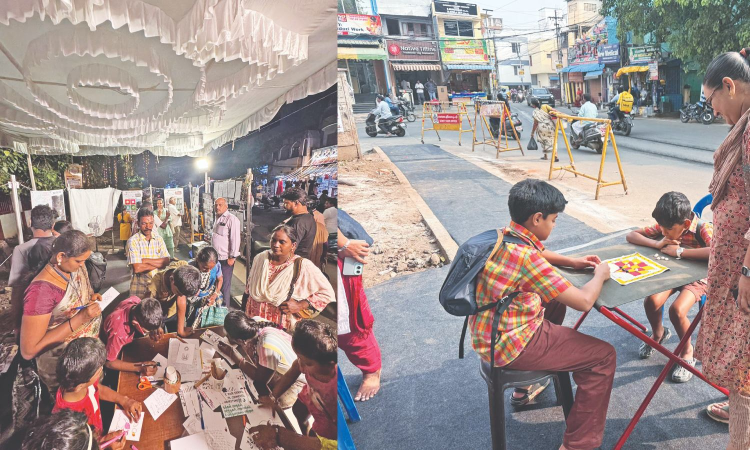Tiruvanmiyur’s Mada Streets set for a community-led makeover
Project Tiruvanmiyur Mada Street began online and came alive through a two-day event that drew nearly 900 participants. The team is now preparing to collaborate with city officials to shape the next phase of improvements for this historic neighbourhood

Photo from the event held at Thiruvanmiyur
CHENNAI: About two and a half years ago, urban planners Dhanya Rajagopal and Pavithra Sriram met near the temple tank in Tiruvanmiyur. Both of them work closely with public spaces, studying how they function and how their vitality can be strengthened. “We are from the same neighbourhood, so it felt impossible not to do something in our own backyard. That was where the idea began,” says Pavithra. From that impulse grew Project Tiruvanmiyur Mada Street, a neighbourhood and heritage precinct improvement initiative centred around the streets that circle the temple.
The project reimagines East Mada Street and North Mada Street that surround the historic Marundeeshwar Temple. What began as an online community with digital archives and online conversations recently moved into the real world through a two-day event held on November 14 and 15. Almost 900 people walked in to participate. The event featured a photo exhibition, photo walks along the Mada Veedhi, a story walk exploring the temple’s history and architecture, and a showcase of traditional games. “People were incredibly supportive. We gathered a huge amount of information. Everyone agreed that some kind of improvement is needed because it is a very special space,” she says.
From the beginning, the team wanted the effort to grow organically, involving every stakeholder in the process. They spent months gathering data, understanding how the area functions, and exploring how changes could improve pedestrian life. The temple, with a history of 1,000 years, became the anchor for the entire effort. “The temple is such an important structure. The project also looks at how we can begin recognising this as a temple town, how the presence of the temple can influence and enrich the neighbourhood around it.”
A key aim was to build a sense of ownership within the community. The neighbourhood holds the memories of many generations, and the team was careful not to impose an outside idea. “We did not want to bring in a design that could exist anywhere. We wanted to listen to the people who live and work here and understand their stories and their needs,” shares Pavithra, who is also the co-founder and urban planner at Design Co Lab.
The project identified three main stakeholder groups. “The first are the residents of Mada Street, each with different expectations for life on the street. The second group is the people who use the street as a daily route. The third includes temple visitors and tourists, who see the area as a cultural landmark and a potential point of pride for the city. We are looking at how the city can use its existing infrastructure more thoughtfully, improve the experience for pedestrians and enhance the livability of the entire locality.”
In the coming weeks, the team will compile the information they have gathered and work with corporation officials to discuss the next steps. “We want to turn this into a living reality for the community. The data from the last two days has given us the strength to move this project forward,” Pavithra concludes.



